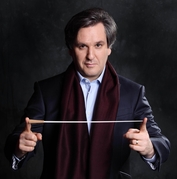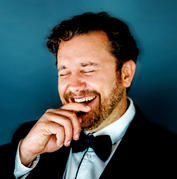

John Nelson
News
Berlioz: Roméo et Juliette - Cléopâtre
”What makes Hector Berlioz such a great composer?”, asks conductor John Nelson. “In one word, originality ... He broke all existing traditions of orchestration, structure, harmonic language and storytelling. Even today, his music is fresh, surprising us at every turn with inexpressible beauty.” Nelson now adds two more astonishingly original works by Berlioz – Roméo et Juliette (described by the composer as a ‘dramatic symphony’) and La Mort de Cléopâtre (a ‘lyric scene’) – to his Erato discography. It already contains such Berlioz landmarks as Les Troyens, La Damnation de Faust, Harold en Italie, Nuits d’été, Grande Messe des Morts (Requiem), Benvenuto Cellini and Béatrice et Bénédict.
For the new release, Nelson continues the fruitful relationship with the Orchestre philharmonique de Strasbourg, his choice for the recordings of Les Troyens, La Damnation de Faust, Harold en Italie and Nuits d’été. Joyce DiDonato, his unforgettable Didon and Marguerite, returns as the suicidal Cléopâtre and she is joined in Roméo et Juliette by tenor Cyrille Dubois (who was Iopas in Les Troyens), baritone Christopher Maltman, and the choruses of the Lisbon-based Gulbenkian Foundation and Strasbourg’s Opéra du Rhin.
Roméo et Juliette was premiered in 1839, some 12 years after Berlioz saw an English theatre company perform Hamlet and Romeo and Juliet in Paris. The young composer had found Shakespeare’s plays a revelation. As he wrote: ‘A lightning flash revealed to me at a stroke the whole heaven of art … I recognised the meaning of grandeur, beauty, dramatic truth …” He also fell passionately in love with the actress who played both Ophelia and Juliet, Harriet Smithson. Five years later, she became his wife.
With Roméo et Juliette Berlioz sought to create a new artistic fusion. As he recounted: “I settled on the idea of a symphony with choruses, vocal solos and choral recitative, for which Shakespeare’s drama Romeo and Juliet would be the sublime and eternally fresh subject.” In his preface to the ‘dramatic symphony’ he wrote: “Let there be no misunderstanding about the genre of this work. Although voices are often employed, it is neither a concert opera nor a cantata but a choral symphony. If singing is featured almost from the start, it is so as to prepare the listener’s mind for dramatic scenes whose emotions and passions are to be expressed by the orchestra alone.” In a letter to his librettist Émile Deschamps, he had even said: “It is an orchestra performing an opera!”.
In June 2022, John Nelson conducted Roméo et Juliette in Strasbourg. The music historian Brian Robins wrote in Early Music World that “the performance was one to renew admiration for the astonishing originality of Berlioz’s conception and for John Nelson’s splendid ongoing Berlioz cycle.” In particular, Robins admired Nelson’s “ability to inspire the augmented Strasbourg orchestra to playing of the greatest fervour and affecting sensitivity,” and noted that “The extraordinarily bold writing in the passage marked ‘Roméo au tombeau de Capulets’ – a sequence of extreme conflicting emotions – came across with vivid, searing intensity.” As for the singers, Cyrille Dubois matched “the glitteringly agile wind playing in the Scherzetto that ends Part 1, ‘Bientôt de Roméo’,” ensuring that its quick-fire vocal patter was “superbly delivered”, while “Joyce DiDonato … sang the Strophes section with utterly gorgeous tone,” and “Christopher Maltman’s Père Laurence … brought great authority and dignity to the Finale and reconciliation scene.”
While Joyce DiDonato did not sing La Mort de Cléopâtre in Strasbourg, in summer 2022 it was the work that marked her debut at the annual Berlioz Festival staged in the composer’s birthplace, La Côte-Saint-André, south-east of Lyon. As Forum Opéra wrote: “She loves Berlioz and serves him with complete commitment … She ‘lived’ La Mort de Cléopâtre with the most passionate intensity and sensitivity …Her exceptional vocal capacities, from a stunning lower register to boldly projected high notes, are deployed with the skill of a supreme tragedienne.”
Les Troyens wins big at the International Opera Awards
At the sixth International Opera Awards ceremony at London's Coliseum last night, Warner Classics' 4CD Berlioz extravaganza Les Troyens was named Recording of the Year (Complete Opera).
Conductor John Nelson, a veteran pioneer of this epic work, said in a statement: 'It is with enormous gratitude that I accept this award on behalf of the extraordinary musicians who surrounded me. This is truly a stunning achievement by French artists interpreting the greatest French opera. Vive la France and Vive Berlioz!'
Hailed the opera event of the year, this critically acclaimed Les Troyens was recorded last year in Strasbourg with a cast of more than 250 singers and instrumentalists led by mezzo-soprano Joyce DiDonato as Dido, contralto Marie-Nicole Lemieux as Cassandra and heroic tenor Michael Spyres as Aeneas. It is already widely acknowledged as the benchmark recording for this Mount Everest of French opera.
See all the winners of the International Opera Awards here.
'Les Troyens' and Debussy Chamber Music win at the BBC Music Magazine Awards
The BBC Music Magazine Awards took place today in a ceremony at Kings Place in London.
In the Opera category, the winner is Berlioz's Les Troyens: the milestone 4CD opera recording on Warner Classics with an all-star cast headed by Joyce DiDonato, Marie-Nicole Lemieux, Michael Spyres and Marianne Crebassa, with the Orchestre Philharmonic de Strasbourg and maestro John Nelson.
The Chamber Music Album of the Year award went to the critically-acclaimed Debussy Chamber Music album on Erato, featuring pianist Bertrand Chamayou, violinist Renaud Capuçon, cellist Edgar Moreau, Emmanuel Pahud (flute), Gérard Caussé (viola) and Marie-Pierre Langlamet (harp). Bertrand Chamayou accepted the trophy on behalf of his colleagues, and played Clair de lune solo at the ceremony to celebrate the Debussy centenary year.
Congratulations to all this year's winners, who can be found in the May issue of BBC Music Magazine.


